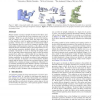Free Online Productivity Tools
i2Speak
i2Symbol
i2OCR
iTex2Img
iWeb2Print
iWeb2Shot
i2Type
iPdf2Split
iPdf2Merge
i2Bopomofo
i2Arabic
i2Style
i2Image
i2PDF
iLatex2Rtf
Sci2ools
TOG
2008
2008
Upright orientation of man-made objects
Humans usually associate an upright orientation with objects, placing them in a way that they are most commonly seen in our surroundings. While it is an open challenge to recover the functionality of a shape from its geometry alone, this paper shows that it is often possible to infer its upright orientation by analyzing its geometry. Our key idea is to reduce the two-dimensional (spherical) orientation space to a small set of orientation candidates using functionality-related geometric properties of the object, and then determine the best orientation using an assessment function of several functional geometric attributes defined with respect to each candidate. Specifically we focus on obtaining the upright orientation for man-made objects that typically stand on some flat surface (ground, floor, table, etc.), which include the vast majority of objects in our everyday surroundings. For these types of models orientation candidates can be defined according to static equilibrium. For each...
| Added | 15 Dec 2010 |
| Updated | 15 Dec 2010 |
| Type | Journal |
| Year | 2008 |
| Where | TOG |
| Authors | Hongbo Fu, Daniel Cohen-Or, Gideon Dror, Alla Sheffer |
Comments (0)

